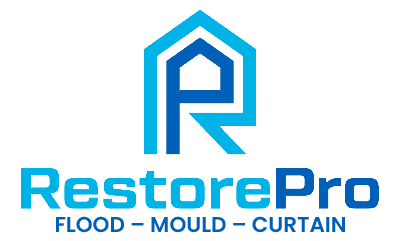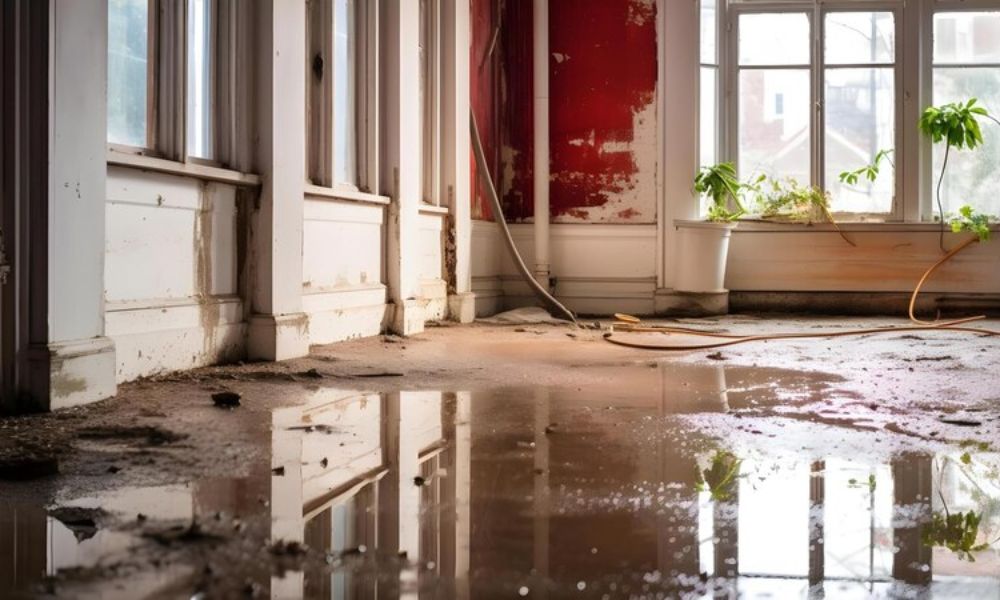Flood and water damage restoration is the process of fixing properties that have been damaged by water. It starts with removing standing water using special tools to prevent further damage. After this, drying machines and dehumidifiers are used to get rid of all moisture, which helps prevent mould and mildew from growing. Finally, the damaged parts of the property are repaired or replaced, making the building safe and sound again.
This process is important because it prevents structural damage and health risks associated with water damage. Proper restoration not only fixes visible damage but also ensures the property is safe for its occupants, maintaining the building’s integrity and preventing future problems.
Understanding how this process works shows why flood and water damage restoration is crucial for property owners.
Why is Flood & Water Damage Restoration Important?
Flood and water damage restoration is important because it prevents severe structural damage to properties. Water damage can weaken walls, ceilings, and floors, leading to potential collapse. The close connection between water and structural damage means that addressing one often involves addressing the other.
Moreover, ignoring water damage or delaying the response can lead to long-term health risks from mould, bacteria, and pests. Proper restoration ensures that these hazards are eliminated, safeguarding the health and well-being of the building’s occupants. It highlights the expertise required to perform such work effectively and underscores the importance of timely and professional intervention.
Acting promptly and using professional flood and water damage restoration services not only saves money on potential repairs but also helps to save valuable items and ensures a safe, healthy living space for residents.
What are the Major Causes of Flood & Water Damage?
Understanding the main causes of flood and water damage is essential for effective prevention. Here are some common sources:
- Broken Dishwasher Hoses: These can cause significant water leakage if they crack or become detached. Regular inspections and replacements can help prevent this issue.
- Leaking Pipes: Even a small crack in a pipe can release up to 950 litres of water daily, leading to substantial structural damage over time. Regular plumbing checks are crucial to catch and fix leaks early.
- Flood Waters: Natural disasters such as heavy rains, hurricanes, or river overflows can lead to sudden and severe flooding. Proper drainage systems and flood barriers can mitigate this risk.
- Structural Failures: Issues like roof leaks, foundation cracks, or poor sealing around windows and doors can allow water to enter a building. Regular maintenance and timely repairs are essential to address these vulnerabilities.
Regular maintenance and proactive measures, such as annual inspections and replacing old pipe fittings, are key to reducing these risks. Preventive actions are crucial to maintaining the integrity of a building and avoiding costly repairs. Investing in regular checks and maintenance ensures the longevity and safety of your property.
What are the Signs of Flood & Water Damage?
Identifying signs of flood and water damage promptly can greatly reduce the extent of the damage. Quick recognition helps prevent further damage and can lower restoration costs and time. Here are common signs of water intrusion and damage:
- Musty Smells: Persistent musty odours are a key sign of mould and mildew, which often follow water damage incidents. These odours indicate that water has been present long enough for mould to start growing, usually within 36 hours of moisture exposure.
- Discoloured Walls and Ceilings: Water stains or spots on walls or ceilings clearly show water damage. These discolourations can vary from clear, slightly yellow to brown, depending on how long the water has been present and the materials impacted.
- Wet Carpets: Moisture trapped in carpets can ruin the fabric and also provide a breeding ground for mould and bacteria. This usually happens due to flooding or leaks from nearby water sources.
- Soaked Boundaries: Waterlogged baseboards or swollen woodwork show prolonged exposure to water, often from leaks or flooding. This can weaken the structure of the building if not handled quickly.
Addressing these signs immediately is crucial to effectively manage the impact.
What Are the Steps Involved in Water Damage Restoration?
The process of flood and water damage restoration is comprehensive and meticulous, starting with an in-depth inspection to pinpoint the scale and kind of damage sustained. After assessing the situation, the critical steps of removing and extracting water begin to prevent further harm. Following this, the next stages involve drying, dehumidifying, cleaning, and sanitising the affected areas to ensure they are safe and restored to their original condition.
Addressing water damage swiftly can save you significant amounts of money, especially when considering the potential impact on flood and water damage restoration costs. For instance, in New Zealand, failing to promptly address flood damage can escalate restoration costs from a few hundred to several thousand dollars, depending on the damage’s severity and the room’s size.
Conduct a Water Damage Inspection
Carrying out a water damage inspection is a critical initial step in the restoration process. It involves a thorough check of ceilings, walls, and floors to determine how much damage has occurred. This inspection is crucial for figuring out how severe the water damage is and what kind of water damage it is. The inspection is systematic and ensures every affected area is spotted and properly categorised to help in an effective restoration plan.
Here are the main parts of the inspection process:
- Damage Assessment: Inspectors look at the effect on different materials and structures, searching for signs of water entering and soaking into materials. This includes looking for changes in colour, swelling, and how solid the ceilings, walls, and floors are.
- Moisture Mapping: Using tools like moisture meters and thermal imaging cameras, technicians create a map of moisture in various building materials. This helps understand how far and deep the water has spread.
- Classification of Damage: With the data gathered, the damage is put into one of four categories. This classification aids in deciding the right response. Class 1 means there is minimal soaking and damage, while Class 4 means there is a lot of deep water damage.
- Documentation: Detailed notes, photos, and videos are taken to record the state of the property for insurance claims and future reference. This ensures everyone understands the extent of the damage clearly.
Understanding these steps can help you grasp the importance of a detailed water damage inspection and prepare you in case you ever need such a service.
Remove Standing Water via Extraction
Once you’ve checked for water damage, the next important step is to get rid of any standing water. This is done using strong vacuums and pumps. Removing the water quickly is crucial because it stops the water from soaking into materials like wood and drywall, which can increase damage. Fast water removal also helps prevent the growth of mould, which can be harmful to your health and can damage your property further.
Specialist restoration technicians use advanced equipment to remove large amounts of water quickly. This is important for lowering moisture levels fast, which helps prepare for the next steps of drying and dehumidification. This process usually costs several hundred dollars, depending on how much water needs to be removed and how big the area is.
Dry and Dehumidify Affected Areas
After extracting water, the next step is to dry and dehumidify the impacted areas using high-quality dehumidifiers and air movers. This stage is crucial to prevent mould growth and additional damage to the structure. Professional restoration technicians oversee this process, which is essential for maintaining the building’s integrity and the health of its occupants.
The drying and dehumidifying process includes several important steps:
- Positioning Dehumidifiers: Technicians place dehumidifiers strategically across the affected areas to draw moisture from the air, creating an environment that discourages mould growth and secondary water damage.
- Using Air Movers: These devices help circulate air around walls, carpets, pads, and furniture, accelerating the evaporation of moisture.
- Monitoring: Technicians regularly check humidity and moisture levels using moisture meters and other sensors. This helps them track the effectiveness of the drying process.
- Making Adjustments: Based on the data collected, technicians may adjust the number and placement of air movers and dehumidifiers to ensure the area dries thoroughly and quickly.
The entire process usually takes between 2 to 5 days, depending on the extent of the damage and the materials involved. Regular monitoring and adjustments are crucial to avoid secondary damage and ensure a successful restoration.
Clean and Sanitise All Surfaces
After you have dried and dehumidified your space, the next step is to thoroughly clean and sanitise all surfaces that were affected by water damage. This is important to prevent mould growth and eliminate harmful contaminants, ensuring your environment is safe after flooding.
Professionals use top-quality disinfectants and antimicrobial treatments to fight against bacteria and other dangerous contaminants that often thrive after floods.
Proper sanitisation involves treating every surface—walls, floors, countertops, and even personal items—with powerful cleaning agents. Effective cleaning methods might include steam cleaning, using ultraviolet light to kill pathogens, and applying substances that stop mould and microbes from coming back.
It’s crucial to follow industry standards and protocols closely during this process. Restoration experts meticulously select and apply the right biocides to ensure the area is not only visibly clean but also sanitised at a microbial level. This careful approach reduces health risks associated with water damage and helps ensure the environment is genuinely clean and safe.
Repair and Reconstruct if Necessary
Severe water damage often necessitates repair and reconstruction to ensure the safety and habitability of buildings and homes. This process is crucial to maintain the structural integrity and comfort of the affected properties. The extent of the damage can require anything from minor repairs to a complete overhaul.
Here are the essential steps in the repair and reconstruction process:
- Thorough Inspection: A detailed inspection of the building is crucial before starting repairs. This step involves checking the walls, ceilings, and floors to determine how much work is needed.
- Replacing Structural Elements: Often, parts like drywall, insulation, and sometimes entire walls need replacing. This is crucial to avoid problems like mould growth and structural weaknesses in the future.
- Drying and Dehumidification: Once the damaged elements are replaced, it’s important to dry and dehumidify the area thoroughly. This helps stabilise the climate inside the building.
- Final Restoration: The final step is about adding the finishing touches such as painting and restoring utilities. This ensures the property looks as good as new, if not better.
How Can You Prevent Future Water Damage?
To avoid future water damage, it’s crucial to regularly check and replace old pipe fittings and hose connections. This should be done yearly, as even a minor crack in a pipe can release up to 950 litres of water each day. Regular inspections of your plumbing system not only save water but also help prevent serious water damage.
Prompt action is vital when dealing with initial water damage to avoid further problems like mould growth and structural decay. Sticking to a maintenance schedule dramatically lowers the risk of severe water-related issues. The best strategy for dealing with water damage is prevention. This means careful monitoring and quick repair work.
Need Immediate Flood & Water Damage Restoration?
Flood and water damage can be devastating, but you don’t have to face it alone. At RestorePro, we provide expert restoration services to swiftly return your property to its pre-damage state.
Don’t let water damage take control. Act now to prevent further damage and ensure a safe, dry home. Contact us at 0800 843 776 or email info@restorepro.co.nz. Our dedicated team is ready to help you through every step of the restoration process, giving you peace of mind and a restored home.

